|
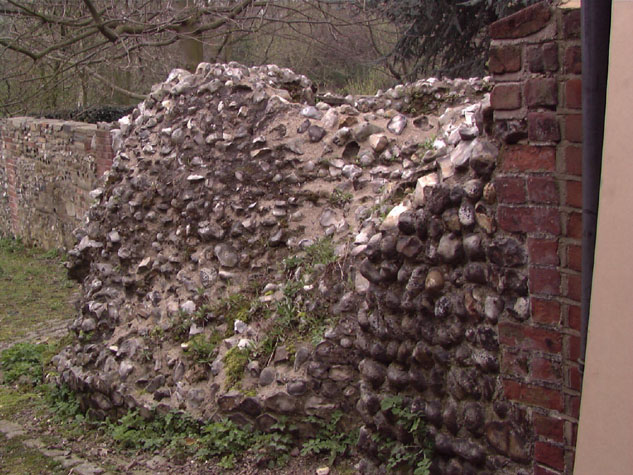
[3] The remains of the tower from the south east looking towards
the river.
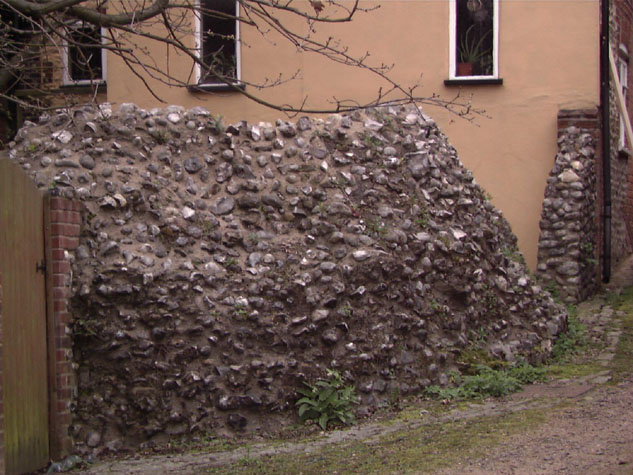
[4] The tower from the west.
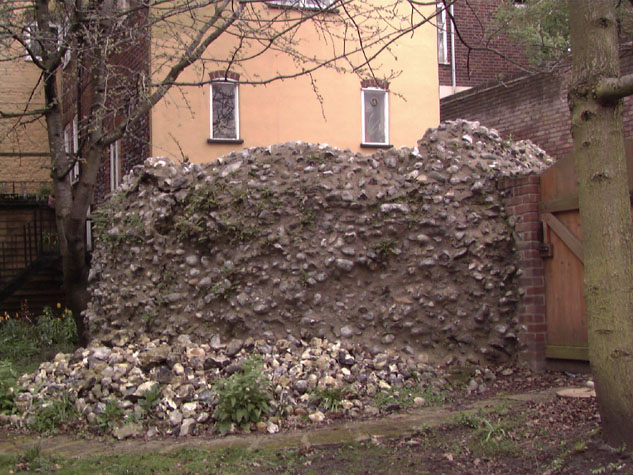
[5] The remains of the tower from the north west.
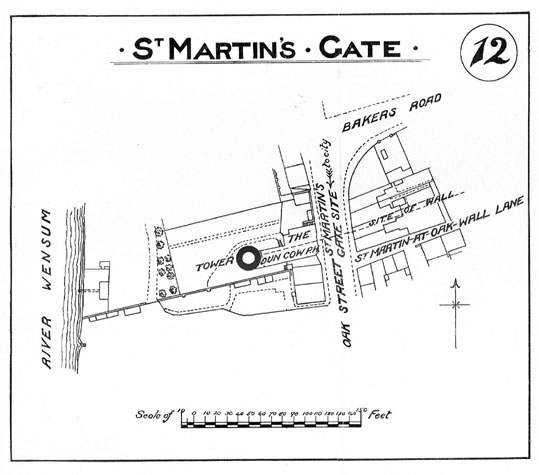
[6] Map showing the tower published in the report by A Collins of
1910.
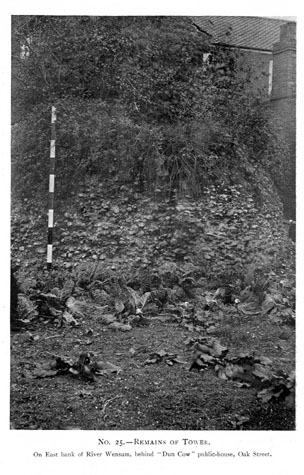
[7] Photograph of the tower published in the report by A Collins of
1910.
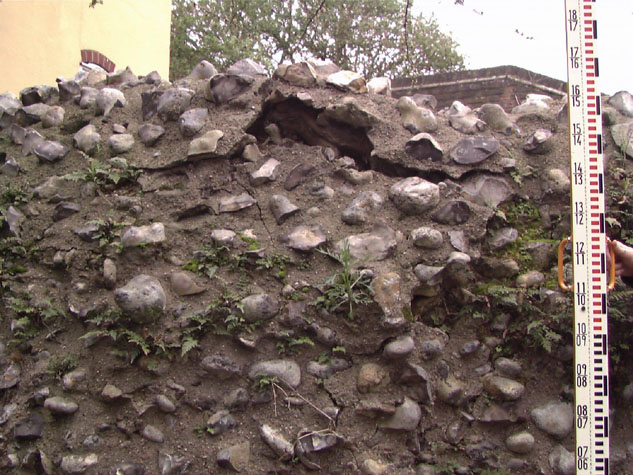
[8] Damage on the north side of the tower caused by the root of a
self-seeded shrub.
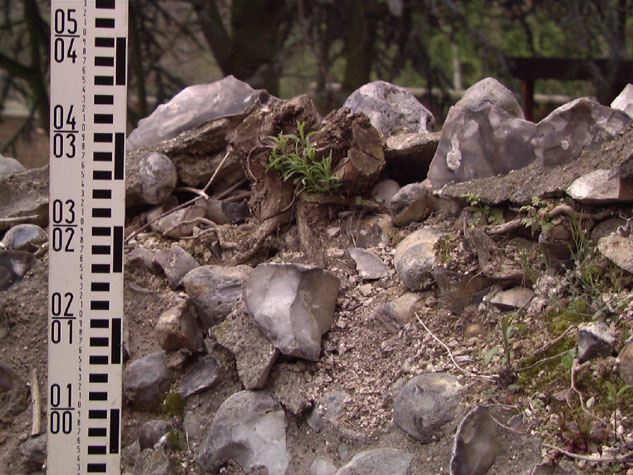
[9] The root stock of the shrub remaining on the top of the wall on
the inner side.
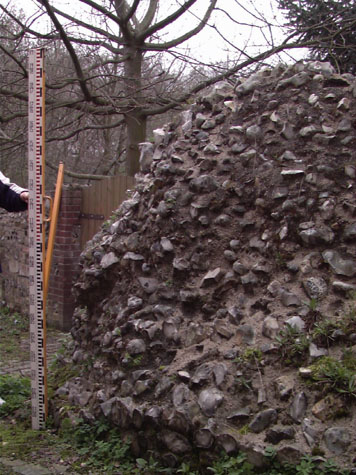
[10] The tower from the west showing the exposed core of the wall
and shed flints.
|
Historical Background Report
Summary
The tower is of considerable historic
interest. With the lost tower on the river bank east of Heigham Gate
it closed the northern defences of the city and is comparable in form and
in function to the riverside tower near Pockthorpe Gate and the two Boom
Towers on the south side of the city.
From the present mound of flint work here
now it is difficult to imagine the substantial tower that stood on this
site. [Photographs 3 & 4 and survey drawing
13-03 Ext Elev] It had the same diameter as the east Boom Tower and
may have been almost as tall ... possibly 8 metres high. The tower
would have been relatively tall in order to have as level a top to the
wall between the gate and the river as possible.
General description of the historic fabric
The surviving flint forms a circular mound
with the top of the wall being rounded. No face flints survive on
the south or inner side and the north side towards the garden looks much
rebuilt. [5] There is no indication of a
plinth or thickening of the wall at the ground. The centre of the
tower is hollow and has an internal ledge just above the ground though
this is much damaged and irregular. [survey drawing
13-05 East Sec] It may represent the level of the floor of
the lower chamber. A set back on the north-east side may represent
the splayed jambs of a loop that would have looked back along the outer
face of the wall towards St Martin's Gate on Oak Street. There is no
evidence for a doorway into the lower chamber from outside on the inner or
south side. This is difficult to reconcile with the descriptions of
the tower in the 19th century as having vaulting. If it was the
lower chamber that was vaulted how was it entered or has the base been so
extensively rebuilt that the evidence for a doorway has been lost?
If the tower had an upper chamber and that was vaulted, a lower chamber
could have been entered by way of a ladder dropped down from above through
a hatch in the floor.
The wall in the basement of the former Dun
Cow is 3.2 metres long and forms an internal wall of the cellar. It
is on the line of the defensive wall though it is not proven to be
medieval. The flint is painted and there are no features within the
wall.
Documentary evidence:
The Oak Street Tower is mentioned by Blyth
in 1842 as being on the west side of the St. Martin's Gate site, on the
end of a small wall, 'the remains of a tower, which is going fast to
ruin.' He notes that as 'The rivulet [is] at some distance west
from the tower, it has been conjectured that this channel is altered, as
this wall was undoubtedly designed to meet the stream.'
Considering the wall from this place back to St. Augustine's Gate, Blyth
comments that there 'are several towers, now converted into habitations,
and the wall is chiefly built upon.'[Blyth, pages
4 and 5]
This is the tower that Fitch mentions as
surviving next to the river in 1858. [Fitch,
page 24]
There is a letter from the Department of
National Heritage (HSD9/2/1005pt10) contained in Gressen Hall file 384,
concerning proposed works at the Dun Cow, House on the Wall, at 167 Oak
Street. It refers to the construction of a new extension to the existing
building along the road frontage.
Map evidence:
Cunningham's map of 1558 shows not only
the tower west of St Martin's Gate but also a length of wall beyond the
tower running down to the river bank. There is no surviving evidence
to suggest that this wall existed and it is still probable that the tower
was actually on the river bank. That is the arrangement drawn by
Cleer on his map published in 1696. Neither Hoyle in 1728 nor
Blomefield in 1746 show the tower though both show the way the river split
here with a narrower stream to the west and a bleaching ground on the
island between the stream and the main channel.
The maps suggest that drainage in this area
had been altered. The assumption must be that in the 13th century
this ground was very wet and marshy providing a form of natural defence.
Water and wet land probably came right up to the tower. If the river
was channelled at all it was further down stream, closer to the site of
the mill and where the defensive wall resumed close to the east side of
Heigham gate where there was another circular tower.
The Oak Street tower is shown on the
Hogenberg and Braun's version of King's map in the 1760s though there
it is set back from the river bank. Hochstetter's map of 1789 is
important as it depicts not only the surviving wall and tower but also the
gate at St Martins shortly before it was demolished. This shows the
relationship of the wall and gate. Unlike many of the gates, St
Martin's Gate was set back with the outer face of the gate flush with
the outer face of the wall. The map is too late to show the
arrangement of the fore works of the gate and the ditch here which by that
date had been filled in with gardens on the site east of the gate.
There were houses outside the gate along the top of the bank on the west
side of the road. The lane inside the walls to the south of the
tower is shown but at that stage it ran down to a narrow stream with the
main channel of the river further to the west.
The map published with the report of 1910
shows the wall and tower much as it is now. The house east of the
tower, facing onto Oak Street is labelled as the Dun Cow Public House. [6
& 7]
Historic views and historic photographs:
On his pencil drawing of the tower dated
1850 Henry Ninham wrote that,
'This is the only tower
remaining with any portion of its original vaulting -It stands at a
very important point between Coslany Gate and the river and overlooks the
whole range of meadows to Heigham and Hellesdon. It was probably one of
those repaired or rebuilt by Richard Spynk Citizen of Norwich in 1342.'
The drawing itself shows vaulting and three
arches, all in brick. The ceiling is ruined just above the vaulting. By
then, the tower was in an advanced state of decay with daylight coming in
and grass growing around the top. [NCM 1929.89.39:INT, 'Interior of
one of the Towers on the City Walls, St. Martin's at Oak Gates, 1850']
Archaeological reports:
There are no reports on file for any
archaeological investigations of the tower or the wall here.
CONDITION SURVEY
List of known repairs:
Not available at this stage.
Summary of present condition:
Generally the base of the tower is in a poor
state of repair and susceptible to further damage. A large area of
fallen flints has accumulated against the base on the garden side and
several root stocks of self seeded buddleia on the top of the wall have
caused deep fissures to open through the flint work. [8
& 9] Once water enters these cracks there will be more damage
and more loss of flints.
Consolidation of the remaining part is
needed urgently.
Principal conservation problems:
The main problem is damage from water
entering the exposed core ... there is virtually no face flint surviving.
There is presumably also some damage from vandalism as children climb or
play on the wall.
- Shedding flints on the face and top of the wall
Considerable quantities of flints have
been lost. It would be difficult to replace or rebuild any of the
tower but the surviving base should be re-pointed and all loose flints
re-bedded. [10] It is particularly
important here that the right mortar mix is used and that it is allowed
to set properly. Hard cementitious mortars that set too rapidly
pull away from the flints leaving gaps through which water penetrates.
- Intrusion of woody stemmed plants
Thick roots of self-seeded buddleia on the
north side of the base have caused deep fissures in the flint work.
It is not enough simply to cut the bushes down as they quickly re-grow.
It is important to treat the root or even to take down flint work to
remove the root completely before rebuilding.
|
